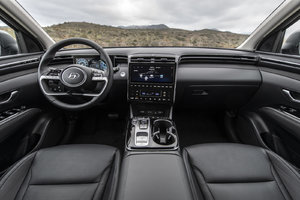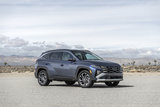The 2024 Hyundai Tucson arrives on the market with three distinct powertrain options, each tailored to different driving habits and efficiency goals. Whether it's the standard gasoline engine, the innovative hybrid, or the versatile plug-in hybrid, Hyundai offers choices that cater to a range of preferences. Here's a deeper look into what sets each model apart, helping potential buyers decide which Tucson fits best with their lifestyle.
Standard Gasoline Engine: Balanced Performance
The base model of the Tucson is equipped with a 2.5-litre GDI engine, known for its reliable performance. This engine delivers 187 horsepower and 178 lb.-ft. of torque, providing ample power for everyday commuting and road trips alike. With a combined fuel economy of 9.1 L/100 km, it offers a competent balance of performance and fuel efficiency, making it an ideal choice for those who prefer traditional gasoline engines without the complexity of hybrid systems.
Hybrid: Efficiency Meets Power
Hyundai's hybrid model integrates a 1.6-litre turbocharged engine with a 44.2 kW electric motor powered by a 1.49 kWh lithium-ion battery. This setup boosts the total output to 226 horsepower and 258 lb.-ft. of torque. More than just added power, the hybrid's real appeal is in its enhanced fuel efficiency, achieving a notable 6.4 L/100 km combined fuel economy. This makes the hybrid Tucson a great option for drivers looking to cut fuel costs and reduce emissions without sacrificing performance.
Plug-In Hybrid: Maximum Efficiency and Flexibility
The plug-in hybrid version of the Tucson pushes the boundaries with its 1.6-litre turbocharged engine complemented by a more powerful 66.9 kW electric motor and a substantial 13.8 kWh battery. This configuration not only increases the combined power output to 261 horsepower but also allows for an impressive all-electric range of up to 53 kilometers. When operating on gasoline, the combined fuel consumption is approximately 6.7 L/100 km. However, considering the electric usage, this can drop to as low as 2.9 L/100 km for ultra-efficient driving. The PHEV model is particularly suited for those who have access to charging facilities and wish to maximize their use of electric power, significantly lowering operating costs over time.
Cost Considerations and Added Benefits
Price variations reflect the technological advancements across the Tucson lineup. The standard gasoline Tucson starts at $34,199, providing a cost-effective entry into the crossover market. The hybrid model, priced at $40,599, offers advanced fuel efficiency for a moderate price increase. The plug-in hybrid, starting at $49,499, represents the top tier, eligible for government rebates of up to $5,000, which can substantially offset the initial cost.
Each powertrain is available with premium features, especially in the higher trims, including leather seating, a Bose audio system, and advanced driver-assist technologies, making the Tucson not just economical to run but also a pleasure to drive.
Interior Specifications of the 2024 Hyundai Tucson: Comparing the Different Models
When selecting a new vehicle, understanding the subtle differences in interior dimensions between models is crucial, especially for families or those who prioritize space and comfort. The 2024 Hyundai Tucson, available in three distinct powertrain options — gasoline, hybrid, and plug-in hybrid — maintains a consistent roominess across models with slight variations. Below is a detailed table that outlines the interior specifications for each model, providing a clear comparison to help you decide which model suits your needs best.
Interior Dimensions of the 2024 Hyundai Tucson
|
Specification
|
Gasoline Model
|
Hybrid Model
|
Plug-In Hybrid Model
|
|
Head Room (1st Row/2nd Row)
|
968 mm / 990 mm
|
968 mm / 990 mm
|
968 mm / 983 mm
|
|
Leg Room (1st Row/2nd Row)
|
1,052 mm / 1,050 mm
|
1,052 mm / 1,050 mm
|
1,052 mm / 1,004 mm
|
|
Total Interior Volume
|
4,160 litres
|
4,152 litres
|
3,902 litres
|
|
Cargo Capacity (Rear Seats Down)
|
2,119 litres
|
2,108 litres
|
1,876 litres
|
Headroom: All three models offer nearly identical headroom, which ensures that passengers of varying heights can be accommodated comfortably in both the front and back seats. The slight reduction in headroom in the second row of the Plug-In Hybrid model is minimal and unlikely to impact passenger comfort significantly.
Legroom: Front legroom is consistent across all models, providing ample space for driver and passenger comfort. However, the second row of the Plug-In Hybrid model sees a noticeable reduction in legroom, which could be a consideration for those frequently carrying adult passengers in the back.
Total Interior Volume and Cargo Capacity: The total interior volume decreases from the Gasoline to the Hybrid and significantly in the Plug-In Hybrid, primarily due to the space taken up by the larger battery pack in the Plug-In Hybrid. This also impacts the cargo capacity, with the Plug-In Hybrid offering less space than its counterparts. This reduction might be a critical factor for those needing maximum cargo space for travel or activities.
These specifications highlight that while the 2024 Hyundai Tucson models are generally consistent in terms of passenger space, the Plug-In Hybrid trades some interior and cargo space for its increased efficiency and electric power capabilities. Potential buyers should weigh these factors based on their specific space needs and driving habits, especially those looking for maximum storage or frequently traveling with rear passengers.
In summary, the 2024 Hyundai Tucson presents a compelling range of powertrains to suit a variety of needs, from the standard gasoline for traditionalists, through the efficient hybrid, to the cutting-edge plug-in hybrid for those prioritizing green technology and maximum efficiency. Choosing the right model will depend on individual driving patterns, distance needs, and access to charging facilities, making the Tucson a versatile choice in the competitive SUV market.














